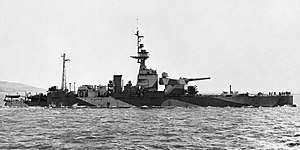HMS Erebus (I02)
HMS Erebus was a First World War monitor launched on 19 June 1916 and which served in both world wars. She and her sister ship Terror are known as the Erebus class. They were named after the two bomb ketches sent to investigate the Northwest Passage as part of Franklin's Lost Expedition (1845-1848), in which all 129 members eventually perished.
 HMS Erebus in 1944 | |
| History | |
|---|---|
| Name: | HMS Erebus |
| Operator: |
|
| Builder: | Harland & Wolff, Govan |
| Yard number: | 492 |
| Laid down: | 12 October 1915 |
| Launched: | 19 June 1916 |
| Completed: | 2 September 1916 |
| Commissioned: | 2 September 1916 |
| Refit: | August 1939 |
| Fate: | Scrapped July 1946 |
| General characteristics | |
| Class and type: | Erebus-class monitor |
| Displacement: | 7,200 long tons (7,300 t) |
| Length: | 405 ft (123.4 m) |
| Beam: | 88 ft (26.8 m) |
| Draught: | 11 ft 8 in (3.56 m) |
| Installed power: | 6,000 ihp (4,500 kW) |
| Propulsion: |
|
| Speed: | 12 knots (22 km/h; 14 mph) |
| Complement: | 226 |
| Armament: |
|
| Armour: | |
Monitors were designed as stable gun platforms with a shallow draught to allow operations close inshore in support of land operations, and were not intended to contest naval battles. Erebus was equipped with two 15 in (381 mm)/42 guns (removed from Marshal Ney[1]) in a single forward turret mounted on a tall barbette to extend the range of fire to 40,000 yd (22.7 mi; 36.6 km).
The Erebus class were designed to outrange German heavy shore batteries and they were also fitted with highly effective anti-torpedo bulges on each side of the hull.
Service history
First World War
During the First World War, Erebus bombarded German naval forces based at the Belgian ports of Ostend and Zeebrugge.
On 28 October 1917, she was damaged by a remote controlled German FL-boat, and suffered the loss of 50 ft (15 m) of anti-torpedo bulge.
Inter-war period
In 1919, Erebus took part in the British Invasion of Russia providing gunfire support in the White Sea and in the Baltic Sea.
In 1921, Erebus took part in gunnery trials against the surrendered German battleship SMS Baden. She then served as a gunnery training ship between the two world wars. Erebus had a refit, completed in August 1939, and was earmarked as guardship at Cape Town, but due to the outbreak of World War II this did not occur.
Second World War
In the early war years, Erebus served with the Eastern Fleet and the Mediterranean Fleet, where she was used to run supplies to besieged Tobruk and bombard enemy concentrations. In 1943, she was damaged while bombarding Sicily during the Allied invasion of Sicily.
Erebus was used for coastal bombardment during the Normandy Landings on 6 June 1944, firing at the batteries at Barfleur and La Pernelle. She suffered one 15-inch gun destroyed due to a premature explosion of the high explosive round in the bore.[2]
On 10 August 1944, she was used against the defenders of the harbour at Le Havre. She was damaged by the battery at Clos des Ronces and was out of action for some time. In November 1944, she supported Operation Infatuate, the amphibious assault on Walcheren, Netherlands.
She was scrapped in July 1946. It is believed that one of Erebus' 15-inch guns was used to equip Vanguard, the Royal Navy's last battleship.[3]
References
External links
| Wikimedia Commons has media related to HMS Erebus (I02). |